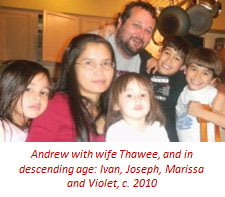Andrew believes his work has shown that by combining some of the old elegant analytical approaches, e.g. multi-mirror anastigmat design using plate diagram design methods, to modern optical design with current computer technology results can be achieved that would be impossible by the ray tracing/numerical optimization methods commonly employed today.
An indication of the success of a new design method Andrew has developed was exhibited when it was applied to the three mirror/one mirror aspherised class of three mirror anastigmats. This new method was able to map out the entire solution set, uncovering new types of three mirror anastigmat, including systems which were both anastigmatic and had zero Petzval curvature. These solutions had not been previously uncovered (or at least not published), despite the growing interest in the field of three-mirror anastigmats over the last three decades and, in particular, over the last decade.
By applying this new design method to four spherical mirror anastigmats the complete range of possibilities for the family of simplest possible reflecting anastigmats has now been fully explored and will soon be published.
There is still a lot to do in this area. Andrew's plans for the remainder of his Ph.D. thesis will include investigating the application of the methods he has so far developed to solving for reflecting correctors for one and two mirror telescopes (e.g. the four mirror spherical aberration corrector of the Hobby-Ebberly telescope), and to systems with more than "4 plates," a generalization of the work Andrew has done so far.
|
Update 2020
Starting in 2019, following several senior positions with major telescope development projects, Andrew became a full-time Principal Consultant with Mersenne Optical Consulting based in New Zealand.
Just prior to his consulting effort, from May 2015 until January 2019, Andrew held a technical leadership role on one of the world’s three “Extremely Large Telescope” projects, the Giant Magellan Telescope (GMT), with technical responsible for all areas of optical performance of the telescope excluding adaptive optics. He was responsible for numerous activities, including: optical design, alignment systems, alignment planning, sensitivity studies, optical input to many subsystems, optical system specification and requirements, technology development, stray-light and polarization.
From May 2012 until May 2015, Andrew performed as a Senior Optical Engineer for the European Southern Observatory. He held technical lead positions on major optical contracts for the new European Extremely Large Telescope (E-ELT). Within ESO’s technical division, Andrew performed general optical design, technology development and telescope improvement work.
From June 2007 until April 2012, Andrew was an Optical scientist within the Large Binocular Telescope Observatory (LBTO) engineering group with responsibility for commissioning and alignment of LBT telescope optics and numerous instruments. Andrew developed a novel approach to collimation which had immediate positive effects on observatory efficiency. He introduced laser tracking to On-Sky telescope alignment in 2012, a world first.
|
|
Update 2010

Andrew received the Kidger Scholarship Award in 2004. At the time, he was both a full time PhD student at the
University of Canterbury, Christchurch, New Zealand and a father of two working for EOS Space Systems in Canberra,
Australia as an optical designer. In 2007 Andrew moved to Tucson, Arizona (and soon after became a father of 4) where he commenced work on the Large Binocular Telescope (LBT) project. The LBT consists of two 8.4 m Gregorian telescopes mounted on a common gimbal. Once it begins true Fizeau imaging in ~ 2012 it can be considered to be the largest optical telescope in the world. Andrew's job is concerned with the optical details of getting this incredible feat of technology to work; alignment, binocular collimation and pointing, tolerancing etc.
|
|

Andrew with wife Thawee, and in descending age, Ivan, Joseph and Marissa, ca April 2007.
|
Update 2007
In April of this year, Andrew submitted his thesis, “Simple Four-Mirror Anastigmatic Systems with at Least One Infinite Conjugate,” to the University of Canterbury, just meeting the four year time limit allowed by the university. Gregg Forbes and Roderick Willstrop have been assigned as external examiners.
Andrew has had one paper fully accepted and two provisionally accepted by Optical Engineering (OE), thus satisfying both his novelty and peer review Ph.D. requirements. His Ph.D. degree is expected to be conferred towards the end of the year.
Andrew has accepted a position as Optical Scientist on the Large Binocular Telescope Observatory, which once it is working will be, by some standards, the largest optical telescope in the world. He and his family expect to move to Tucson to take up his new position sometime in June 2007.
|

